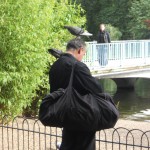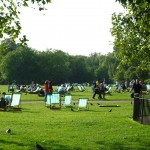September 21st, 2010 · No Comments
As I read George Orwell’s article, I became increasingly interested in where this charming pub, The Moon Under Water, could be found. I will admit I was disheartened when I learned the pub did not actually exist. Nevertheless, I came to understand Orwell and his inability to find his “perfect” pub. I haven’t had extensive experience with pubs here in London, but after evaluating the ones I have visited, I can say I haven’t yet found my favourite pub either.
In regards to the location of the pubs, I have ventured into both the obvious pubs positioned glaringly on busy main streets and the more inconspicuous pubs situated off the beaten path in quieter areas. Like Orwell, my ideal pub is located on a side street where “drunks and rowdies [will] never seem to find their way” (The Moon Under Water, Orwell). The Marlborough Arms, which is just around the corner from the Arran House, is a local sort of pub that offers the intimate atmosphere where a mix of university students and middle-aged regulars can enjoy some privacy as they socialize over a few drinks. The bartenders are friendly (they offered a friend a free drink since her food arrived late) and the owner is also good-humored and amicable.

The Marlborough Arms Pub on Torrington Place, off of Gower Street
The clientele of a pub is also a significant factor in finding a great pub. There are pubs that seem to attract younger crowds, like The Court on Tottenham Court Road. It appeals to young adults mainly because of their young, attractive bartenders, booming beats, and prominent location. It’s a fun setting if you’re in the mood to deal with a jam-packed, noisy pub. Honestly, it reminds me more of a college party scene than anything else. I don’t want to find a number of other American students at the same pub! Another sort of clientele I’ve noticed some pubs gear toward is a tourist. The Rising Sun, also on Tottenham Court, does not seem to follow the normal English pub rules. Their staff seems to have adapted to serving foreigners since, for one, they have waiters who will cater to you as you sit at a table. I prefer the traditional English pub experience where one must go up to the bar to buy food, a round, or to discreetly tip the bartender—just as Kate Fox explains in Watching the English.

The Court Pub on Tottenham Court Road
Another topic Orwell brings up in regards to pubs is the selection of food and drinks. Unfortunately, I have not come across a pub that combines great food and drinks with my ideal pub environment. The ambience at the Marlborough Arms is great—decent music, some noise, a match playing on the telly, friendly patrons, some privacy and comfort—, but the food is mediocre, in my opinion. Moreover, I have had better drinks served elsewhere. Like, for example, the great menu at The Cock a few blocks off of Oxford Street. I agree with Orwell that the quality of food is important for a pub. Superior food and a good selection of drinks add to its comfort and distinctiveness.
Speaking of distinctiveness, I also think it’s important that a pub distinguishes itself from other pubs. As Orwell stated, he enjoys pubs with gardens and he only knows of three that possess them. Moreover, he covers in detail the architectural layout of his ideal pub, The Moon Under Water. Not that I have discovered my preferred “look” of a pub, I have recognized that I like pubs that express some sort of distinction from the rest. My ideal pub should definitely stand out. It could attain this through its architecture, its garden, or even just its quirky name, like The Moon Under Water.

The Old Bank of England Pub on Fleet Street
Sure, I hope to sometime pick a favourite pub, but I also don’t mind exploring all sorts of pubs and their disparate clientele, atmospheres, food and drink selections, patrons, and quirks. In the end, each pub is different; I just have yet to find that one “great” pub. It’s not The Old Bank of England Pub on Fleet Street—a high-class pub near the legal courts that had potential to be the favourite—so maybe I will stumble upon it in Norwich.
Tags: 2010 Mary · Pubs
September 21st, 2010 · No Comments
The Brits pour money into their precious museums, further proof to my idea that the Brits hold their rich and storied history above all things in this fine country. The Museum of London is probably the best example; a simply laid out but large museum with easy access to the public and several treasured pieces of London history contained within its walls. Like the Museum of London, most museums are easily accessible and a majority of them are free to the public, however it seems like the museums they offer are catered to a good balance of Brits and tourists alike. While walking through a museum like the British Museum or the National Portrait Gallery, it is common to hear a slew of accents from every corner of the room. Italian, spanish, english, you name it, these people are in the museums. Of course this kind of museum experience can only come from the British government pouring tons of money into these places, making them into a piece of history themselves.
The history on display in the museums isn’t only that of the Brits, however. I am sure it took millions upon millions of dollars to acquire the historical objects contained in museums like the British museum. Perhaps this is a testament to not only the Brits appreciation of their own history, but also of the history of the world. London is without a doubt, one of the most international cities in the world. Tourists come from all over to see the sights and people from all corners of the globes live tucked away in various corners of London. All these points lead me to believe that Londoners also take great pride in acknowledging how they themselves are linked to international history and will pay big bucks for precious artifacts to be moved to their museums.
The museums themselves seem to operate like any other public establishment in the city of London. The feeling of being pushed around from queue to queue is ever present, even in a place like a museum. The result is that you kind of have to rush yourself from museums, or as a fellow classmate said in their blog recently you have to learn to “skim” museums. It took me ten minutes just to get a good view of the Rosetta Stone because of all the people crowding around, and everyone seems to have you on a two minute timer to have your look and then move on. Even in a place like the National Portrait Gallery, I got the feeling that if I spent too much time looking at a painting or sitting on a couch (the green leather was incredible) I was going to be the recipient of dirty looks from every direction. Despite being invisibly queued up in most sections of museums, there is usually enough to experience for you to get lost for days.
Overall, the museums are definitely a great aspect of London and I believe that the fact that they are subsidized is a very good thing. It keeps tourists coming and it keeps the English aware and proud of their history and their knowledge of others’. The museums of London helped me to appreciate (like a good Londoner) the value of a trip down history lane.
Tags: 2010 Benjamin
September 21st, 2010 · 1 Comment
Seeing churches is an incredible way to see into the past. Why, I asked myself, are there so many hundreds of year old churches still standing in England? Sure there are old buildings standing all over the place, but a vast majority of them are churches. After a little bit of thinking I’ve come up with a few reasons as to why I think very old churches had a better chance of surviving then they did in other places.
Since its founding, England has been one form of Christian or another. Already, this makes the survival rate of churches much higher then a place like Spain or Turkey, two regions since early times has switched hands from Christian to Muslim and perhaps back again. This great decreases the amount of churches destroyed or converted to mosques. This also means that while Edward I exiled the Jews from England in 1290 and their places of worship were probably destroyed and converted, there would be no reason in the history of England to tear down a church.
As we saw in Westminster, most churches had fortified sections in which to store the vast amounts of wealth that were being collected from the surrounding areas. This initiative to make sure churches could withstand attack could contribute to the stability of these structures. This may not be the same way in other parts of the world where vicious Vikings were not raiding the coasts.
These churches also serve as monuments to who, at any given point in history, were worthy of being commemorated in elaborate monuments within these churches. While well known now, we can see by his burial placement that Sir Christopher Wren did not quite have the status or celebrity that victorious military commanders held. The placement of these tombs and varying degrees of fanciness are a window into what was important to the empire in the past.
Tags: 2010 MatthewG · Churches and Cathedrals
September 21st, 2010 · No Comments
One commonality connecting our visits to diverse religious institutions was a certain level of decorum expected of visitors, which was of course implicitly observed by worshippers. In each of these places, visitors could not take any pictures, but there were many other customs which we were asked to observe in respect to each of these places of worship.
For example, in both the Mandir and the Mosque, visitors were expected to take off their shoes before passing beyond the entrance of each of the respective buildings. I feel like I should have asked about this custom while at the Mandir; I understand the justification for this observance of this custom at the Mosque exists because Islamic culture values emphasizing cleanliness. Is it the same justification at the Mandir? And of course, we were expected to not eat pork or smoke before going to the Mosque or Synagogue, due to the respective dietary laws of Islam and Judaism.
It was very interesting to hear about the application of Sharia law in the UK. Most of the Sharia, although observed by faithful Muslims, is not legally codified in the UK. The parts which are legally binding mostly involve marital contracts and business contracts between consenting parties. So, like Christians and Jews (whose religious marriages are recognised by the state), Muslims are allowed to enter these contracts at their behest. It is always interesting to hear the argument that Sharia law should not be allowed in the Western world, despite the fact that these obligations don’t impact anyone except the Muslims who are parties to them. Maybe, if they don’t like Islamic culture being practiced in the West, they should give up other customs which were imported from the Islamic world after the Crusades. Like bathing.
Back what was supposed to be the topic of this blogpost. One major difference between St. Paul’s cathedral and Westminster Abbey on one hand, and the Mandir, Mosque, and Synagogue on the other hand, was that there were burial tombs and cryps in each of the Anglican sites of worship, but none in the Hindu, Muslim, or Jewish sites. But, after thinking about it more, this has to do more with the age of the buildings; the Anglican sites were hundreds of years older than the Muslim, Jewish or Hindu sites.
Tags: 2010 Tyler · Churches and Cathedrals · Uncategorized
September 21st, 2010 · 1 Comment
I’m not much of a history freak, but I think museums are amazing. They serve as a unique interactive learning experience allowing us to actually see and absorb things that we wouldn’t obtain through a textbook or classroom lecture. Seeing artifacts and paintings brings history to life, and this method of learning is preferable by some people and especially for young children for the hands- on experience. It is really cool to be able to walk into a museum, and in London’s case for free, and see something that existed millions of years ago. I’ve always admired to determination of historians to seek the unknown, and figure out when and why something happened, and to openly share this information with the public.
One of my favorite museum trips was earlier on in the month when we visited the Museum of London. I always knew about the Romans, and read about the founding of London and Britain as an empire, but actually physically seeing everything connected all of the random pieces of information in my head. I enjoyed learning about early Roman life, and realizing that we learned cleanliness from them. The women made hair combs, nail clippers, and even tweezers that so closely resemble the beauty essentials women use today. I loved that each floor uncovered different eras of London’s history, which included industrialization, political and social movements, and even fashion.
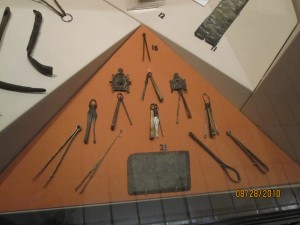
(Roman beauty essentials)
Another one of my favorite museums was the Victoria and Albert museum. Many students disliked this museum the most because it was too hard to navigate, but I actually appreciated the arbitrariness. I was so bored of visiting museums that solely displayed the rich white royalty of England, that is was nice to have a change with something that was completely informal and unplanned. Stumbling room by room through this organized chaos, I realized you could find just about anything in this museum. I was able to admire the fashion styles of Grace Kelly and to jealously look at centuries worth of jewelry worn by generations of rich people.
There were artifacts and sculptures thrown everywhere, it was like a giant garage sale. In the section with mosaics and paintings, we found a mosaic of Rome by Antonio Testa that took him twenty years to complete. This museum was filled with thousands of artifacts, my only question is where did they get all of this stuff from? I was trying to think of a coherent way that they could have organized everything, but honestly it would be impossible. So whether the designer just gave up on figuring out a floor plan, or intended it to be this way, I really enjoyed it.
Tags: 2010 Melissa · Uncategorized
September 21st, 2010 · 1 Comment
Since I’m most of my visits to pubs have been for meals, I’ll use my pub post to talk about the meal that I’ve ordered most often: fish and chips. George Orwell describes food as something that varies from pub to pup: to some extent, this is still the case, however, fish and chips is a constant, and in fact it is very similar from one pub to the next.
The presentation of fish and chips in pubs shows a definite lack of pretension. On the menus, the dish is usually labeled as just “fish and chips,” sometimes, “served with mushy peas.” And what you get on your plate is just that: fried fish, sometimes over the chips, and sometimes next to them, with tarter sauce, but no more fancy sauces or toppings besides those such as catchup and vinegar that are already on the table. Customers are free eat any of the condiments on the table with their fish and chips. My first time ordering fish and chips, I was not sure what mushy peas would be, but they are exactly what their title suggests, definitely mushy, and not very much like vegetables, served simply in a small container or on the plate with the fish and chips. At the Court, which much of our group has frequented, fish and chips meals are offered in medium and large serving sizes. This, as well as the presence of vinegar, catchup etc. shows that customers are familiar with ordering fish and chips, and have specific preferences.
After ordering fish and chips at a few restaurants that are were pubs, I realized that the quality of the same meal decreased dramatically. To be fair however, these restaurants were both in highly touristy areas, one by the British Museum, and the other in Bath. At both, I was served more hard breading than fish, and the fish itself did not taste nearly as fresh. Since the two fish dishes were so similar, I wonder if they got the fish frozen and already breaded from the same provider. The fish and chips at both of these restaurants also cost over seven pounds, as compared to the five or six pounds that I usually spent on the same (and better) meal at pubs. Clearly, the touristy restaurants do not need to worry about providing their customers with good food, because they get new customers who do not know where to find good food every day. The difference in quality demonstrates that people who know where to go, and are truly looking for a good meal go to pubs.
Something else that I noticed about eating meals at pubs, is that although the food is simple, they are certainly not designed for quick meals. After we order, food can take upwards of fifteen minutes to arrive. When I ate lunch with a few other students during a forty-five minute lunch break, we were left with only five or ten minutes to eat after our food arrived, and inevitably we were a little late to get back to class. I think that this is because pubs are truly places to hang out and to relax, instead of simply places to go for a meal. Whether going for an evening out or just a plate of fish and chips for lunch, customers are expected to take their time, and enjoy socializing with the people they are there with, instead of just eating and leaving.
Tags: 2010 Emily · Uncategorized
September 21st, 2010 · 1 Comment
Regent’s Park, like all of London, is composed of winding and difficult to follow paths. It contains massive open fields and has a number of soccer pitches and tennis courts. The sports fields immediately set Regent’s apart from St. James and The Green Park. In Green, the main activity was a good sit and St. James has banned sports.
Aesthetically , St. James and Regent’s are also quite different from one another. Regent’s is grand; it seems as though it strives to impress. And, certainly, in my opinion it does not fail. There are manicured gardens with varieties of annual flowers in picturesque arrangements. The gardens are mulched and created with distinct lines. It has expansive views, with long open fields and a good look at the city from Primrose Hill. Fountains and statues with hanging flowers populate the Avenue Gardens and the Queen Mary Garden’s are equally impressive. The gardens will consist of multicolored flowers arranged in intricate patterns.
At St. James the attempt is evidently for a natural look. The flowers, while some are manicured, are more often wildflowers in large patches, with various flowers intermixed in an elegantly effortless manner. The waterfowl and stream provide for a beautiful look and the Pelicans are massive and elegant. I’ve seen pigeons, ducks, geese, swans and pelicans, which make for a lovely array. The view from Blue Bridge down the entire canal and to the surrounding buildings is another great one. St. James also has more randomly placed trees throughout the park.
In the end, I find Regent’s to be more attractive. It has it’s manicured parts, which are nice to walk past and get a look at, but my favorite aspect is the expanse of the park. With so much room it is always possible to find a nook to sit alone, undisturbed.
Tags: 2010 Michael
September 21st, 2010 · No Comments
London could, and rightly should, boast about its parks. The amount of space the city has reserved for outdoor enjoyment is outstanding. The largest parks, Hyde, St. James, and Regents, have fantastic gardens, bodies of water, and wildlife. Initially, I was going to do a tour of Hyde Park for my walking tour. This park specifically hit me with its beauty.
So what is it that makes Hyde Park so special?
From what I have noticed, London is a city leading the way in healthy living, and Hyde Park lends itself to that. The amount of space for games and exercise is astonishing Both times I visited there had to be three dozen football matches being played. These games and others are played on the Parade Grounds. A large, flat, green lawn, these grounds give visitors the space to run around, though they have to share it with the ones trying to relax. There is a track around the park that w
alkers, cyclists, and runners share with each other. There is tennis center and also horseback riding. I think even Central Park in New York has gotten ride of horseback riding. Anyway, there is a Barclays bike station right near one of the entrances that allows people to cruise around and enjoy the sun (or clouds).
Another aspect of Hyde Park that makes it unique is the facilities that allow people to… chill out. This is another part of London culture that I’ve seen: Londoners need for relaxation. There are green and white striped deck chairs that dot much of the green space around the park. People are able to take paddleboats out on the Serpentine (the body of water within Hyde Park that I will get to in a second). From what I saw, there were also two restaurants that were placed on the shore of the Serpentine. Though it might now seem like much, there are cafés all around the park where people sit and drink coffee, eat cake, and talk.
For a city, London definitely embraces its animal inhabitants. The Serpentine is a long body of water that attracts lots of birds, ranging from Canadian geese to swans to exotic birds. The people along the shore feed them, the birds allowing them to get so close that people can feed them out of their hands. The squirrels too, they go right up to people and take food from their hands! I had never seen that happen except for here in London. Its such an unusual relationship that the animals and people have.
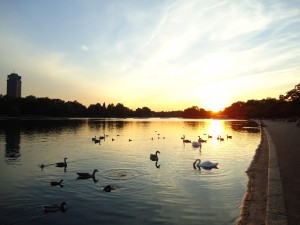
The park also includes many memorials, statues, and historical spots. The first thing you see when you reach Hyde Park from Oxford Street is Speekers Corner. Since the late 19th century, people have spoken there about anything they were interested in preaching. There is a 7/7 memorial and a fountain dedicated to Princess Diana. The most interesting one in the park is the Isis statue. It resembles a crane is meant to inspire people to cherish the wildlife that they have around them. It recognizes the relationship that I previously talked about.
In many ways, Hyde Park incorporates the culture of London into its beauty and nature.
Tags: 2010 David
September 21st, 2010 · No Comments
We have been to our fair share of churches, cathedrals, and other religious buidings. Looking up at the incredible painted ceilings and windows at these cathedrals, a visiting American would typically think, “My church doesn’t look like this”. The churches of London have been constructed by world famous architects for hundreds of years. The role of churches in London differs vastly from the purpose of churches in the United States (this we have discussed several times). The main purpose of these churches is rooted moreso in the Brits deep pride and value in their rich history a bit moreso than the prayers and sermons that are uttered in the buildings.

Westminster Abbey
Since my time spent here I have noticed that the Brits care a lot about, and ruthlessly display their long, inspiring history. I believe that these churches (St. Pauls, Westminster Abbey, etc.) serve as living pieces of history for the Brits moreso than places of worship for that reason. Walking through Westminster Abbey almost seems like your at some sort of Rock N’ Roll hall of fame for famous people’s graves. I can’t think of a better way of preserving and glorifying history than walking through a museum of dead guys with significant roles in the history of London. The elegant layouts and statues where the heroes of London stand frozen in time give places like the Abbey almost a museum-type feeling. I especially felt this way on our tours in the Abbey and St. James, where I felt like we were being ushered from exhibit to exhibit. The basement of St. Paul’s was even undergoing work so that they could put an exhibition on display, not unlike a museum.

St. Paul's Cathedral
Of course, these churches do still hold religious ceremonies; I saw a wedding at St. Pauls one of the days we went there, and there was a moment of silent prayer when we were touring Westminster Abbey. Our tour guides explained at several of the sites about how their regular services proceed as well. These religious observations still seem to be playing second fiddle to the awesome, breathtaking history that the churches hold. I am sure that more people attend tours than services on a daily basis at a place like St. Pauls or Westminster Abbey. Along with the Brits’ pride and dedication to their history, these churches serve as spots that honor the unification of London and its people as a whole. Hell, the entire country had a national religion in the Church of England for many, many years. One country, the majority of which were a member of one religion, and the church for which all these buildings were constructed. Our tour guide at St. Pauls explained how during the Blitz, a chaotic period that made the people of London fear for their lives on a day to day basis, that as long as they could see St. Paul’s church everything would be alright. Quite a deep belief on the part of the people of London. A belief reinforced by their nature of being proud of their past and their knowledge of it. So, while these churches and cathedrals might appear to be some kind of religious museum, they remain some of the most well recognized and inspiring aspects of London.
Photos courtesy of: members.virtualtourist.com, lilacnet.net
Tags: 2010 Benjamin
September 21st, 2010 · 2 Comments
With sunny skies and a temperature of 20 degrees, yesterday was the perfect day to get out of the museums and visit Kew Gardens. To get to the Kew Gardens tube stop, you take the Northern line to Embankment, and transfer to the westbound District line trains terminating at Richmond. The ride from Embankment to Kew Gardens took a little over 30 minutes, so plan to spend at least 2 hours at the gardens to make the trip worthwhile. After leaving the Kew Gardens tube stop, you must take a brisk five minute walk down a tree lined street, to the Victoria gate of the Royal Botanical Gardens.
The entrance fee at the gates is £13.50 for adults, but £11.50 if you bring your student ID. At the entrance, I saw several people showing cards and being allowed quick entrance without buying tickets. Later, when I spoke to a guide I inquired what this card entailed, and the guide explained that many of the denizens of the surrounding area had purchased membership in order to enjoy the privilage of visiting the park for free whenever it was open. Even though the neighborhood by the tube stop was quite scenic and had lots of open public space, it became apparent to me that the ammenities that the park provided made a full membership worthwhile if you lived in the surrounding area.
As you walk down the path from the entrance, you are greeted by the sight of a diverse selection of trees from arround the world, neatly arranged in groves to the sides of the path. Along the way, I spotted what is believed to be the oldest tree in Kew Gardens, a Sweet Chestnut tree thought to have been planted in the early 18th century. The Sweet Chestnut tree is thought to have been introduced from Southern Europe by homesick Romans who were known to use the chestnuts to produce flour and other edibles.
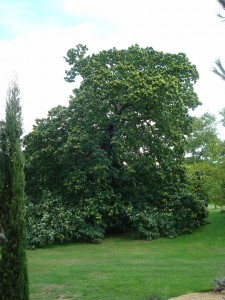
I decided to walk to the southern end of the Gardens, toward the Japanese landscape garden, with a “Chokusi-Mon” replica in the center. Chokusi-Mon means “Gateway to the Imperial Messenger” in Japanese, and this temple was a replica of one in Kyoto.

There was also a peacock just chillin’ to the side of the path, next to a bush! Some of the other visitors, who seeing from their accents were British, passed by and made clicking noises to get the attention of the bird. They were not very sucessful, but it reminded me of Kate Fox’s discussion about how Brits like to talk to pets and animals for as a coping mechanism for their social dis-ease.

Finally, I visited the Princess of Wales Conservatory, which contained several plant selections from several climate zones, including a Tropical Rainforest, Desert, Tropical and Temperate Ferns, and an Orchid room! There were live butterflies in several of the rooms, but I couldn’t take any pictures because I used all of the spare memory on my camera. If you are ever in London again, and want to escape the bustle of the city, go to Kew Gardens!

Tags: 2010 Tyler · Uncategorized





